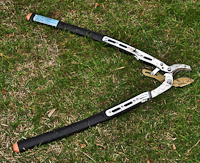Once on a live T.V.
interview, I was asked, "Why are they called loppers?" I
wasn't expecting the question and the best I could come
up with was, "Because they lop things off."
Anyway, the next step up
the pruning ladder from hand pruners are basically the
same cutting mechanism with longer handles. The extra
length give you more leverage and, therefore, more
strength to cut those larger branches.
 Since the cutting
mechanisms are the same for loppers and hand pruners,
the comments above are the
same.
Since the cutting
mechanisms are the same for loppers and hand pruners,
the comments above are the
same.
In addition to the
cutter, the key factor in choosing a pair of loppers is
the material used to make the handles. Generally, the
stronger the handles, the higher the quality and the
higher the price.
The cheaper loppers will
have more fragile handles of a low quality wood or
metal. If the metal handles bend under the pressure of
making a cut, they will probably never work right.
Good quality loppers will
have high quality steel in the cutter and a strong,
composite type material in the handles. They will
withstand a lot of pressure and stay sharp for long
episodes of pruning.
Another factor in lopper
quality is the presence and capacity of "bumpers" that
cushion the handles as they are squeezed together. These
are usually made of a heavy quality rubber and they will
help reduce the stress on your shoulders if you do a lot
of lopping.



